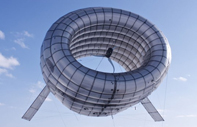Altaeros Energies' Floating Wind Turbines Tap Into Strong High Altitude Winds
 In an effort to harness strong high-altitude winds, the company Altaeros Energies has developed a floating wind turbine that’s a cross between a traditional windmill and a blimp. After some successful tests, the Altaeros team is confident that this new levitating wind turbine will be a viable clean energy option for remote villages and military sites.
In an effort to harness strong high-altitude winds, the company Altaeros Energies has developed a floating wind turbine that’s a cross between a traditional windmill and a blimp. After some successful tests, the Altaeros team is confident that this new levitating wind turbine will be a viable clean energy option for remote villages and military sites.The design of the Altaeros’ Airborne Wind Turbine is pretty simple. An inflatable, helium-filled shell lifts it off the ground to high altitudes, where winds are much stronger than at ground level. The airborne turbines are held steady by strong tethers, which send electricity generated by the turbine back down to the ground.
“For decades, wind turbines have required cranes and huge towers to lift a few hundred feet off the ground where winds can be slow and gusty,” said Airborne Wind Turbine inventor Ben Glass in a release. At higher altitudes, not only are winds more than five times stronger, but they’re also more consistent.
Altaeros Energies was founded in 2010 by MIT and Harvard alums. Earlier this year, the team completed testing of a 35-foot scale prototype of the Airborne Wind Turbine in Limestone, Maine. There, the floating turbine climbed to 350 feet off the ground, generated power, and landed in an automated cycle. According to a press release, the prototype produced more than twice as much power at high altitude than generated at conventional tower height.
There are of course other benefits to having a wind turbine that floats high above the ground. For one, it produces very little noise, and it requires little maintenance (and what maintenance it does require can be done at ground level). Additionally, the inflatable shroud covering the wind turbine blocks the spinning blades from being visible to nearby communities.
You can return to the main Market News page, or press the Back button on your browser.

